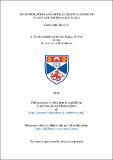Files in this item
Photoporation and optical manipulation of plant and mammalian cells
Item metadata
| dc.contributor.advisor | Dholakia, Kishan | |
| dc.contributor.author | Mitchell, Claire A. | |
| dc.coverage.spatial | 248 | en_US |
| dc.date.accessioned | 2015-03-25T16:05:33Z | |
| dc.date.available | 2015-03-25T16:05:33Z | |
| dc.date.issued | 2015-06-24 | |
| dc.identifier.uri | https://hdl.handle.net/10023/6328 | |
| dc.description.abstract | Optical cell manipulation allows precise and non-invasive exploration of mammalian cell function and physiology for medical applications. Plants, however, represent a vital component of the Earth’s ecosystem and the knowledge gained from using optical tools to study plant cells can help to understand and manipulate useful agricultural and ecological traits. This thesis explores the potential of several biophotonic techniques in plant cells and tissue. Laser-mediated introduction of nucleic acids and other membrane impermeable molecules into mammalian cells is an important biophotonic technique. Optical injection presents a tool to deliver dyes and drugs for diagnostics and therapy of single cells in a sterile and interactive manner. Using femtosecond laser pulses increases the tunability of multiphoton effects and confines the damage volume, providing sub-cellular precision and high viability. Extending current femtosecond photoporation knowledge to plant cells could have sociological and environmental benefits, but presents different challenges to mammalian cells. The effects of varying optical and biological parameters on optical injection of a model plant cell line were investigated. A reconfigurable optical system was designed to allow easy switching between different spatial modes and pulse durations. Varying the medium osmolarity and optoinjectant size and type affected optoinjection efficacy, allowing optimisation of optical delivery of relevant biomolecules into plant cells. Advanced optical microscopy techniques that allow imaging beyond the diffraction limit have transformed biological studies. An ultimate goal is to merge several biophotonic techniques, creating a plant cell workstation. A step towards this was demonstrated by incorporating a fibre-based optical trap into a commercial super-resolution microscope for manipulation of cells and organelles under super-resolution. As proof-of-concept, the system was used to optically induce and quantify an immunosynapse. The capacity of the super-resolution microscope to resolve structure in plant organelles in aberrating plant tissue was critically evaluated. | en_US |
| dc.language.iso | en | en_US |
| dc.publisher | University of St Andrews | |
| dc.subject | Biophotonics | en_US |
| dc.subject | Plant cells | en_US |
| dc.subject | Photoporation | en_US |
| dc.subject | Ultrafast lasers | en_US |
| dc.subject | Super-resolution microscopy | en_US |
| dc.subject | Optical trapping | en_US |
| dc.subject.lcc | TK8360.O69M5 | |
| dc.subject.lcsh | Optical tweezers | en_US |
| dc.subject.lcsh | Transfection | en_US |
| dc.subject.lcsh | Plant cells and tissues | en_US |
| dc.subject.lcsh | Femtosecond lasers | en_US |
| dc.title | Photoporation and optical manipulation of plant and mammalian cells | en_US |
| dc.type | Thesis | en_US |
| dc.contributor.sponsor | Engineering and Physical Sciences Research Council (EPSRC) | en_US |
| dc.contributor.sponsor | James Hutton Institute | en_US |
| dc.type.qualificationlevel | Doctoral | en_US |
| dc.type.qualificationname | PhD Doctor of Philosophy | en_US |
| dc.publisher.institution | The University of St Andrews | en_US |
| dc.publisher.department | James Hutton Institute | en_US |
This item appears in the following Collection(s)
Items in the St Andrews Research Repository are protected by copyright, with all rights reserved, unless otherwise indicated.

